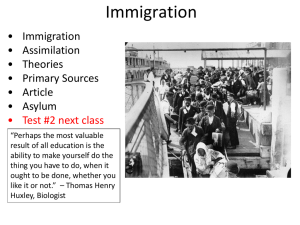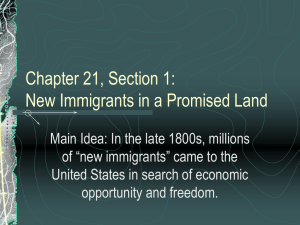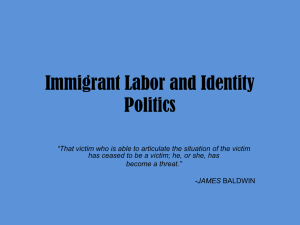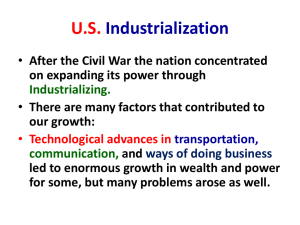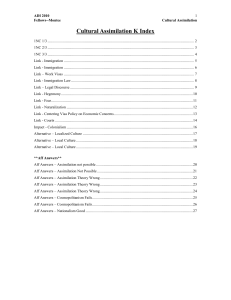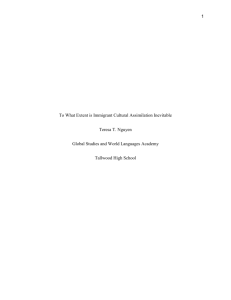illegal immigration
advertisement
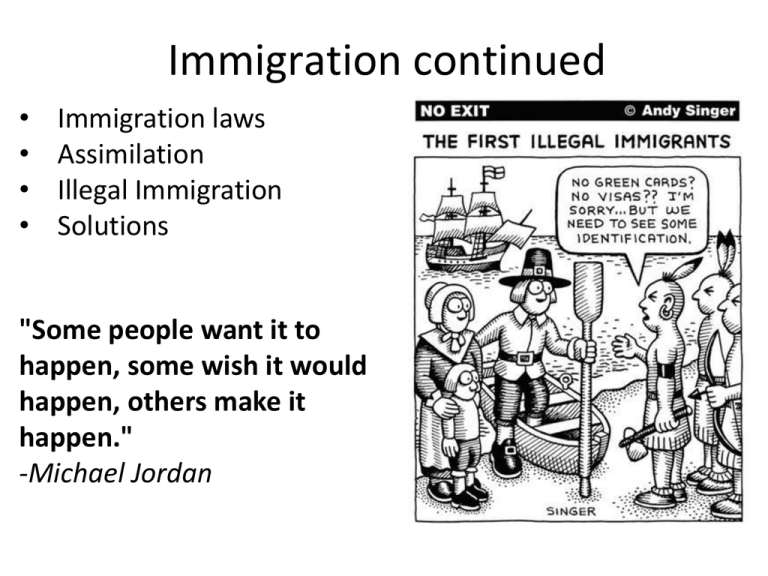
Immigration continued • • • • Immigration laws Assimilation Illegal Immigration Solutions "Some people want it to happen, some wish it would happen, others make it happen." -Michael Jordan Test 2 Question #7 missed by 60% of the class, extra point given Question #14 marked wrong accidently on scantron, corrected Extra Credit Power Point Option: Sociologists to Know Extra Credit 5 minute Power Point Presentation (or Prezi.com) Select a sociologist (sign up in class next class) Describe the following: brief background of their life, 2-3 major contributions to sociology, how is their work relevant today? 4 points possible Present on: Nov 5th, Nov 6th Samples and details on website http://soc101.weebly.com/extra-credit.html Sociologists to choose from: 1. Emile Durkheim 2. Max Weber 3. Charles Horton Cooley 4. Karl Marx 5. Herbert Spencer 6. Harriet Martineau 7. Jane Addams 8 George Herbert Mead 9. W.E.B DuBois 10. Talcot Parsons History of Discrimination in Immigration Law National Origins Act 1924: Southern Europeans and East Asians and Indians 1950’s eject suspected Communists from the country (usinfo.state.gov) History of Discrimination in Immigration Law The ethnic background of immigrants was particularly important during times of national crisis Great Depression: Mexicans and Mexican-Americans faced mass deportation justified by economic problems Post World War II: 1954 "Operation Wetback," President Eisenhower a speculated 1 million Mexicans were deported along with their U.S. born children in response to labor competition Effects of Post 9/11 Security Measures USA Patriot Act of 2001: put immigration under the control of Department of Homeland Security 2003: Men from Pakistan and Saudi Arabia in US, legal immigrants, had to register for the controversial National Security Entry-Exit Registration System or face deportation. What is assimilation? I am a ... 1. 2. 3. 4. First generation immigrant (came to the U.S. not born here) Second generation (parents came to the U.S., born here) Third generation (grandparents came to U.S.) Family has been in the U.S. more than 3 generations Assimilation 1. Robert E. Park’s traditional assimilation theory 2. Milton Gordon’s contemporary views 3. Horace Kallen’s cultural pluralism . Robert Park’s traditional assimilation model, assimilation occurs after 3 generations. • 1st: struggle to learn the new way of their new country and hold on to many aspects of their culture. American According to Robert Park’s traditional assimilation model • 2nd: attend public schools learn English better than their parents may move out of ethnically grouped neighborhoods marry someone outside of their race. Still seen as outsiders and may consider themselves outsiders as well American Robert Park’s traditional assimilation model • 3rd: move completely into the mainstream of American life. learn a few words of language, recipes, proverbs, t will speak mostly English Questions regarding their nationality will seldom arise American Robert Park’s traditional model, assimilation occurs after 3 generations. • 1st: struggles to learn the new way • 2nd: learn English better than their parents, may move out of ethnically grouped neighborhoods, marry someone outside of their race. Still seen as outsiders • 3rd: move completely into the mainstream of American life. In your opinion or personal experiences has this been true? Criticism of traditional assimilation model 1. Ignores age of entry: children who arrive at young age with parents may feel more like 2nd generation Criticism of traditional assimilation model 2. Ignores race: Does not accurately describe experiences of nonEuropean groups in America. Criticism of traditional assimilation model 3. Ignores choice: Voluntary versus involuntary entrance (slavery) effect likelihood of following the 3 generation model Criticism of traditional assimilation model 4. Ignores group size, concentrations, and time of entry 5. Ignores similarity between the and culture of the majority. culture of minority Milton Gordon’s Contemporary Views on Assimilation Gordon described 7 different sub processes of assimilation Milton Gordon’s Contemporary Views on Assimilation 1. Cultural (practices and traditions) 2. Structural (schools, jobs, housing, recreational spheres of society) 3. Marital (acceptable partners) 4. Identificational (the group you identify with) 5. Attitudinal (prejudice) 6. Behavioral (discrimination) 7. Civic (political power, representation in politics) assimilation. Melting Pot vs. Salad Bowl Italian Cuban Japanese Italian Cuban Cultural Pluralism America America Japanese Horace Kallen’s Cultural Pluralism Minority groups should be accepted as completely Americanized without being required to disappear as distinctive groups. Majority’s culture is added to the minority’s culture rather than substituted Italian Cuban Japanese Cultural Pluralism America Melting Pot vs. Salad Bowl Cultural Pluralism Which do you feel is better for the United States? Where are most legal immigrants from? Top 10 in 2010 Source: U.S. Department of Homeland Security http://www.dhs.gov/xlibrary/ assets/statistics/publication s/natz_fr_2010.pdf Mexico India Philippines China Vietnam Colombia Dominican Republic Cuba Haiti Jamaica Terms Immigrant does not = illegal immigrant Illegal immigrants also called undocumented workers/ undocumented students Remember immigrant does not =Latino/a What parts of the U.S. do most immigrants settle in? And why? Illinois New York New Jersey California Florida Texas Push and Pull factors of Immigration into the U.S. Push factors Pull factors poverty perception of endless opportunities famine unemployment wars employment family religious freedom military draft economic freedom religious or political persecution ILLEGAL IMMIGRATION Views for deportation of illegal immigrants Views against deportation of illegal immigrants Asylum may be granted due to Fear of return to country based on persecution related to: • race • religion • political opinion Must show: • 10 years in U.S. • Otherwise clean criminal record • Relative who is a U.S. citizen would suffer exceptional and unusual hardship if deported Pros and Cons of the Solutions (1) More border control. (2) Prevent employers from hiring undocumented immigrants. (3) Withhold government services from unauthorized immigrants. (4) Grant workers a path to gain citizenship or work permits. (5) Give police the authority and responsibility to identify illegal immigrants (Arizona SB 1070) Reflection: a)Which do you think is best? Why? b)Which do you think is worst? Why? c) Can you think of other pros or cons to any of the solutions? Extra Credit Movie Dolores Huerta- Co-founder of United Farm Workers Union Due next week Bring in a media image from a magazine (nonpornographic) that you feel relates to issues of gender Think of an open-ended question to ask the class about the picture. •Type up the question. 4 points •You must be in class to earn full points Read Ch 9: p 210-215 Example: How do sexualized dolls like the Bratz influence young girls? Mid-term check in Students who earn A’s : Students who don’t pass: Keep their goals in mind and work hard Read the syllabus carefully and regularly Read the text book and assigned articles Attend every class, on time, stay the entire class. Listen actively and take notes (using the note taking guides) Participate in class discussions every session Check the course website regularly Ask questions Take advantage of all the extra credit Turn in all assignments on time Use the test study guides Read the scoring rubrics carefully before writing papers Review the Power Points posted on the course website Prepare for the Final ahead of time Think they will pass without putting in effort Ignore the syllabus Don’t ever purchase the text book Miss more than 2 classes Come to class late Daydream Do not participate Rarely or never check the course website Never ask questions Do not take advantage of extra credit Miss multiple assignments, turn in assignments late Do not prepare for tests Do not read paper scoring rubrics Do not review Power Points on website Students who succeed in this class Check syllabus and website regularly Go to class Pay attention and participated Do the reading Study for tests and use the scoring guides The time to improve your grade is now Don’t be this guy at the end of the semester But I really needed an A to transfer to CSUDH/UCLA /USC…etc. I’m only 1 point away from a C, can’t you round my grade up? But I really need to pass to stay eligible for basketball/ football/ track…etc. I didn’t know that I wasn’t passing. But things have been so stressful at home. The best way to improve/maintain your grade is to follow the syllabus: 1. Come to class prepared and participate 2. Study for quizzes 3. Put time and effort into papers, use scoring guide Mid-term reflection purpose Let you know the grade you are earning in the course Find out what your future goals are Help you see exactly what you can be doing to maintain or improve your grade Wake-up call if you are unhappy with your grade Use this for other classes you are in Tips • Learning combination 10-24-7 • Moves information into your long term memory Which of these do you think best explains treatment of immigrants? 1) Cultural Transmission: focuses on how prejudice is transmitted through culture from generation to generation through family and/or media. 2) Group Identification Theory: focuses on how prejudices are tied in with an individual’s racial and ethnic group membership. 3) Personality theories: assert that those with high levels of frustration or authoritarian personalities have higher tendencies of holding prejudice beliefs. 4) Frustration-aggression hypothesis: ethnic prejudices develop in response to people’s need to cope with the frustration in their daily lives. (ICE= United States Immigration and Customs Enforcement) Timeline of significant U.S. Immigration Laws Texas Proviso 1952: makes harboring an illegal entrant a felony, but does not punish those who employ them. Immigration Act of 1965: abolished the national origins quota system. Immigration Reform and Control Act of 1986: made it illegal for employers to knowingly hire illegal immigrants. Illegal Immigration Reform and Immigrant Responsibility Act of 1996: authorized more Border Patrol agents and a triple fence along the San Diego border, USA Patriot Act of 2001: put immigration under the control of the newly created Department of Homeland Security (Kimer, 2005) Real ID Act May 2005: prohibits undocumented immigrants from holding a driver’s licenses Bill 4427 December 2005: Made remaining in the U.S. as an undocumented immigrant a federal felony (en.wikpedia.org) Source: NACLA Report on the Americas; Jul/Aug2005, Vol. 39 Issue 1, p34-35, 2p Source: U.S. Department of Homeland Security http://www.dhs.gov/xlibrary/assets/statistics/publications/natz_fr_2010.pdf
